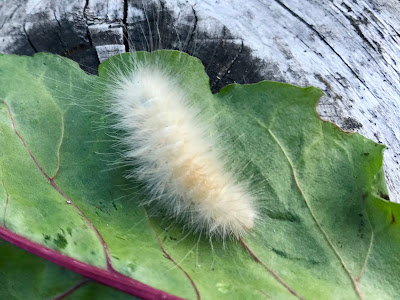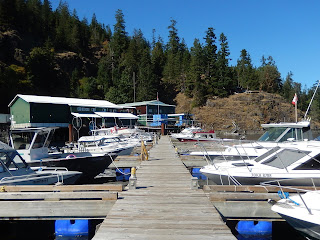 |
| Heading into Refuge Cove. |
We treated ourselves to a four day upcoast cruise in our Bayliner 2452. From Powell River we headed up the
Strait of Georgia to
Refuge Cove on West Redonda Island. We've been here many times for fuel but I've always wanted to spend the night at this active marina.
 |
| Historic Refuge Cove general store. |
Refuge Cove has a long history of providing products and services to loggers and residents of remote Coastal BC.
In summer, the most frequent customers are boaters arriving in everything from small runabouts to huge yachts.
Overnight moorage is first-come, first-serve at a dollar a foot. The fuel dock has gas, diesel and propane. The general store has everything from fresh vegetables to hardware. Other services include a post office, used books, showers, laundromat, garbage service and Internet. We saved our onboard food and had pizza at the
Upcoast Summers restaurant.
 |
| Docked for overnight at Refuge Cove. |
The next morning we waited at the dock for slack tide. We headed up Lewis Channel then angled into Calm Channel. So far all of the waterways have been wide and deep without major tidal influence. That was about to change. Our destination required us to pass through the Yacultas Rapids, Gillard Passage and the Dent Rapids all in one go.
 |
| Approaching the Yaculta Rapids. |
For a landlubber like me, it was a surprise when I learned that the ocean can create whitewater rapids to rival many rivers. But when the tide changes, the waters calm allowing boats to pass. You just have to know when (thanks to the tide tables) and be quick about it. Slack water doesn’t last long before the tide turns and starts running in the opposite direction.
 |
| Blind Channel Resort fuel dock. |
We made it through all three rapids in calm conditions then got back up on plane to travel through Cordero Channel to Mayne Passage along the north side of East Thurlow Island to Blind Channel Resort on West Thurlow Island. The resort has fuel, a store and restaurant. The docks were packed and they had no record of our reservation so we got gas and headed out to Johnstone Strait.
 |
| Johnstone Strait on a good day. |
Johnstone Strait can get some pretty nasty winds, waves and tidal action all mixed into one. Fortunately today, the wind was light.
 |
| Exiting Johnstone Strait. |
We chose to return to an anchorage we used several years ago on the northwest side of Quadra Island.
Small Inlet has a tight entrance with floating bull kelp, but inside it has protection from wind and good hold for anchors. Wayne dropped ours and we had a private spot for the night with only one other boat a long distance away.
 |
| Dropping anchor in Small Inlet or Quadra Island. |
We enjoyed a simple cold chicken dinner. Some people enjoy preparing fancy meals on board. With our small galley it's much easier to bring prepared foods. Plus, we enjoy it that way.
The next morning we again waited for slack tide. We had
three sets of rapids to cross to get over the top of Quadra Island. The Lower and Upper Okisollo Rapids followed by the strongest one in
Beazley Passage (aptly named
Surge Narrows) between
Quadra and Maurelle Islands.
 |
| Motoring slowly through Beazley Passage. |
The flow can get up to 12 knots and pretty rough. You can hear them roar just like a waterfall. Beasley is beautiful as you pass through it’s narrow walls. Then you are back in the open and deep waters of Hoskyn Channel. Looking back north I could see my favourite feature, Cowboy Hat Mountain.
 |
| Cowboy Hat Mountain on the left. |
It's real name is
Mount Doogie Dowler. Don't you thing The Cowboy Hat sounds more appropriate?
 |
| Heriot Bay Inn and Marina |
To cap off our trip we stopped at the Heriot Bay Resort marina. When we are out in the boat it's hard not to go there for a great meal, a trip to the Heriot Bay Store to get a fresh baked pie for dessert and a quiet night at the dock.

I hope you enjoyed your cruise with us in Coastal BC.
Would you like to read more about the area? Check out Wayne’s book
Up the Strait and join us for other exciting trips on the chuck. -- Margy






























































